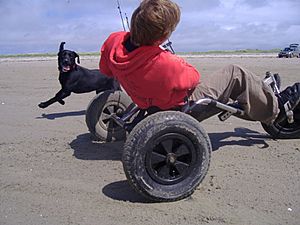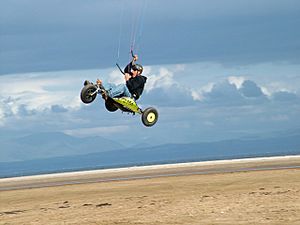Kite buggy facts for kids
A kite buggy is a cool, lightweight vehicle. It's powered by a big, strong kite called a traction kite. Imagine a small car with one seat, one steerable wheel in front, and two fixed wheels at the back. You sit in the middle and steer with your feet. You also control the kite to make the buggy go fast or slow down. This exciting activity is called kite buggying. Skilled drivers can reach speeds up to 110 km/h (70 mph)! Because it's so fast, it's super important to wear protective clothing, especially a safety helmet.
Kite buggies might have been invented in China around the 1200s. Later, in 1827, George Pocock (inventor) helped make them known in the UK. By the late 1970s, you could buy kite buggies in the US and UK. But it was Peter Lynn who really made them popular in the early 1990s. He introduced strong, light, and affordable buggies. Kite buggying is a bit like land yachting or windsurfing. Many of its terms and skills come from these activities. Kite buggies are even called "Class 8 Land Yachts" by FISLY. Competitions often follow land yachting rules.
Contents
How to Drive a Kite Buggy

Driving a kite buggy is all about teamwork between your feet and the kite. The front wheel of the buggy is like a bicycle's fork. But instead of handlebars, it has two foot rests. These foot rests are very important for steering and staying safe.
Steering with Your Feet
The foot rests let you steer the buggy easily. If you push your left foot forward, the front wheel turns to the right. If you push your right foot forward, the front wheel turns to the left. These foot rests also help you stay firmly in your seat. This is important so the strong kite doesn't pull you out of the buggy! Some foot rests have straps or grip tape. These stop your feet from slipping during fast turns. However, foot straps are not good for beginners. If the buggy flips, your feet could get stuck, risking ankle injuries.
The Seat and Power
The buggy has a special bucket-style seat. This seat gives you good support for your back and sides. You need this support because you transfer the kite's power into the buggy through your body. A traction kite powers the buggy. You control this kite with lines and handles. You either hold the lines or attach them to a harness you wear. The kite helps you speed up and also helps you slow down.
Braking the Buggy
Kite buggies don't have regular brakes on their wheels. To slow down or stop, you use the kite. You can turn the buggy into the wind. This makes the kite lose power and helps the buggy stop.
Parts of a Kite Buggy
The way a kite buggy is built, like its frame and wheels, affects how it performs.
Frame Design
The size and shape of the buggy's frame matter a lot. Longer buggies are usually more stable. They are great for going straight and fast. Shorter buggies are better for turning quickly. A wider back axle makes the buggy more stable. It helps prevent the buggy from tipping over. However, doing tricks, like riding on two wheels, is harder with a very wide axle. Most rear axles are about 1.0 to 1.5 meters wide.
Wheels for Different Terrains
Kite buggies use different kinds of wheels. They never have exposed spokes like bicycle wheels. This is to keep your hands and kite lines safe. Here are some common wheel types:
- Thin rim wheels: These are best for very hard ground. They are often used for racing and speed.
- Standard size wheels: These work well on firm or moderately firm sand. They are also good for fields that are not too bumpy. These are good for general buggying and tricks.
- Big foot wheels: These are large wheels. They are best for all kinds of beaches and bumpy fields. They are great for general use, tricks, and even racing.
Weight and Handling
The weight of the buggy and the driver affects how it handles. A lighter buggy is easier to move and turn. A heavier buggy doesn't slide sideways as easily. This means it can use more power from the kite. More power from the kite means higher speeds! Sometimes, people add extra weights to their buggy. These weights are placed low down to keep the buggy stable. Some even fill the hollow tubes of the frame with heavy materials like lead.
Fun Kite Buggy Activities
Kite buggying offers some really exciting ways to ride!
Tandem Buggying
Some buggies can connect to a second buggy. It's like a trailer! A single kite can power both buggies. The person in the first buggy controls the kite. The passenger in the second buggy just enjoys the ride. For expert riders, both buggies can have their own kite. This is called a tandem kite setup. It needs very skilled drivers and great communication.
Special Designs
Most buggies have three wheels. But some special designs have four wheels. These have a more complex steering system. There are even two-wheeled buggies! These have only one wheel at the back. For winter fun, you can replace the wheels with ice skating blades for ice. You can also use cut-down skis for riding on snow.
Buggy Jumping
Buggy jumping is an extreme part of the sport. In this activity, the pilot is actually strapped into the buggy with a lap belt. They use very large kites. The pilot flies the kite high overhead to create a lot of lift. Then, the pilot and the buggy are lifted many feet into the air! Very advanced pilots can even do amazing tricks in the air. These include 360-degree spins, sideways moves, and even landing backward.
Staying Safe While Kite Buggying
Kite buggying is an extreme sport. The wind is the only power, and it can be unpredictable. It's very important to be careful and respect the wind. This goes for beginners and experienced riders alike.
Starting Safely
It's always a good idea to start with a smaller kite. Also, choose a day with lighter winds (like a gentle breeze). As you get better, you can try bigger kites or stronger winds. Beginners should first learn to control their kite perfectly. Only then should they try actual kite buggying.
Being Responsible
Always act responsibly when kite buggying. Make sure you don't harm anyone nearby. Also, don't damage the environment or property. Pick a place with lots of open space. This is very important for safety.
Essential Safety Gear
You must wear protective clothing and a good helmet. Downhill mountain bike helmets are often good. They are light, have good airflow, and let you see well. Paragliding helmets are also a good choice. Regular motorbike helmets might not be as good. They can be heavy and might block your view. You need to see both your kite and the ground around you easily.
Avoiding Accidents
A common cause of accidents is using a kite that is too big for the wind or your skill level. If the kite is too powerful, you might get pulled downwind. You could slide sideways and lose control. To avoid this, use a kite small enough that you can stop the buggy safely. You can do this by turning it into the wind and driving against the wind.
Insurance and Instruction
It's a good idea to get insurance. This protects you if you accidentally hit someone or something. Organizations like the South and West Association of Traction Kiting (SWATK) offer this. Shops that sell kites should also help new riders. They should not sell very powerful kites without suggesting lessons. They should also help organize lessons with certified instructors. Remember, the general code of conduct for all kite-flying activities applies to kite buggying too.


